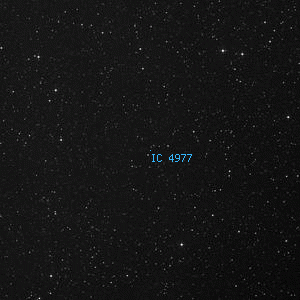IC 4977

Overlaid DSS image of IC 4977, 60' x 60' with north at top and west to the right
Aladin viewer for the region around IC 4977
| Type | Star |
|---|---|
| Magnitude | Right Ascension | 20h 11' 53.3" (2000) |
| Declination | 21° 38' 12" S |
| Constellation | Capricornus |
Observing Notes
Harold Corwin
Earlier, I had written about this object[IC 4977] is the last of seven objects found by Bigourdan for which he gives no details in his tables of differential measures (see IC 532 for more). There is a wide double star and an equally wide triple about an arcminute northwest of his position as listed in his Appendix VII, but there are no nebulous objects nearby. (In SGC, I note "Only a few stars in pos of I4977."). However, Bigourdan does have an interesting note: "Taken for a comet." His "Initial designation" column -- where he notes the GC and NGC numbers of the nebulae he was observing when he found the "nova" -- has a comet symbol followed by "Giac." apparently an abbreviation for Giacobini.In August 2016, I ran through the NGC and IC objects that I had flagged as possible comets. This one was the only "hit" with Bigourdan's observed position on 21 June 1898. The comet was C/1898 M1 Giacobini, in line with Bigourdan's notes quoted above. Interestingly, this comet was very close to Bigourdan's position at about 17:45 UT on 21 June 1898 (ephemeris calculated by JPL's HORIZONS system). I think it's likely that Bigourdan actually did observe the comet, but somehow included it in his list of nebulae, just as he did IC 2120 (which see).
Bigourdan's description, taken from the NGC, "Stellar, close to * 13," suggests that the object is one of the stars (or multiple stars) in the area. We still need to do a detailed search to recover data for the comet on the night of observation, however. IC 2120 (which see), also found by Bigourdan, is in fact a comet, so that kind of mistake does happen in his lists.
Searching through Bigourdan's tables again, I found the object in his Appendix VIII where it is called "4977'" = "Big. 435". Bigourdan has four measures of the object which place it +15.17 +- 0.32 seconds of time and -13.15 +- 4.1 arcseconds from a star "An. 11.5" at "20 05 45, -21 55 13". This star is in turn "-1m 39s" in RA, and "-10'.5" in Dec from BD -21 5647. We now identify Bigourdan's comparison star as TYC 6327-0620-1. It has a good position and the proper motion, though high (+70.0+-3.4 mas/yr in RA, +19.2+-3.3 mas/yr in Dec) is well-known. So, the position of Bigourdan's object will be dependent almost entirely on his measurement.
His full "Descriptions and Remarks" read (my translation), "The measured object, with a stellar aspect, is very near a star 13.2. It was taken at first to be the comet 1898 V (Giacobini). The position of the telescope is doubtful." I am not at all sure what he means by that last sentence, but it is moderately alarming.
Nevertheless, if he has identified his stars correctly, his position becomes 20 11 52.5, -21 37 34 for J2000. This compares with a predicted position of the comet (from JPL's HORIZONS ephemeris calculator) of 20 11 53.4, -21 38 54 at UT = 17:45 on 21 June. However, Bigourdan was probably observing sometime around midnight (he does not give observation times, just hour angles, -2.1 in this case. Given that and the object's RA, its possible to work out the local time, "around midnight"), the comet would have been closer to 20 08 34.0, -21 43 17, 3/4 degree away from his field.
So, while he was perhaps searching for the comet, I think it more likely that the star very close to his position is the object he saw. Unfortunately, he does not tell us which direction the nearby 13.2 magnitude star is located, but there is such a star at PA 295 degrees, distance 0.5 arcminutes. I'm therefore going to take this star as the likely IC 4977.
Other Data Sources for IC 4977
Nearby objects for IC 4977
3 objects found within 120'
| 4 Capricorni | Messier 75 | RT Capricorni |
Credits...
Drawings, descriptions, and CCD photos are copyright Andrew Cooper unless otherwise noted, no usage without permission.
A complete list of credits and sources can be found on the about page
IC 4977